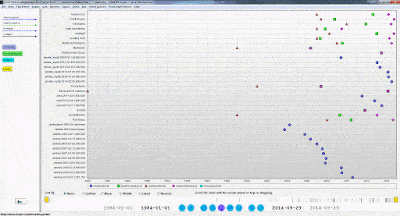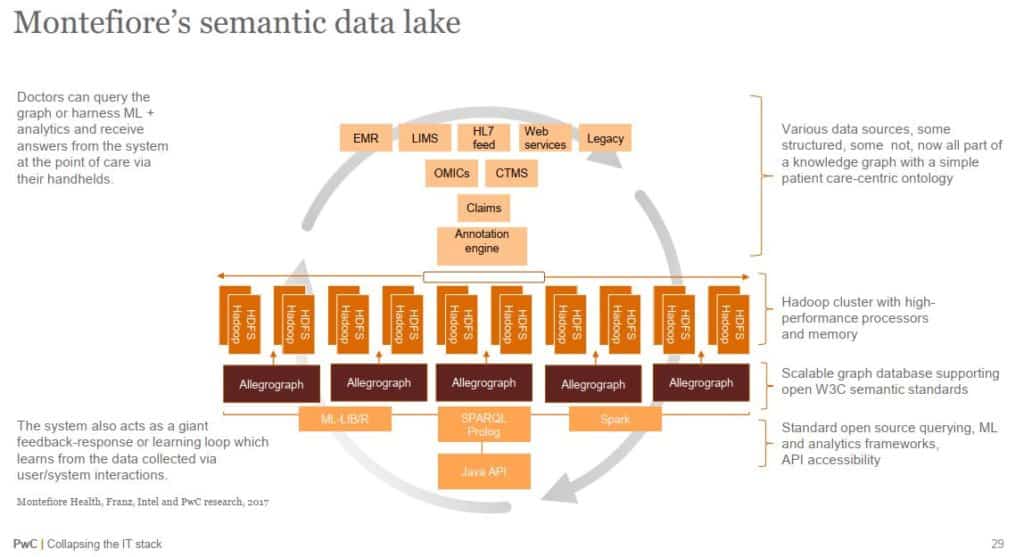Press Release – September 10, 2018
First Semantic Knowledge Graph for a Public Figure will Semantically Link Books, Interviews, Movies, TV Programs and Writings from the Most Cited U.S. Scholar
OAKLAND, Calif. and VIENNA, Austria — Franz Inc., an early innovator in Artificial Intelligence (AI) and leading supplier of Semantic Graph Database technology, AllegroGraph, for Knowledge Graphs, and Semantic Web Company, developers of the PoolParty Semantic Suite and leading provider of Semantic AI solutions, today announced a partnership to develop the Noam Chomsky Knowledge Graph. This project is the first aimed at connecting all the works from a public figure and turning the linked information into a searchable and retrievable resource for the public.
The Noam Chomsky Knowledge Graph project will organize and semantically link the vast knowledge domain surrounding Noam Chomsky, the founder of modern linguistics, a founder of cognitive science, and a major figure in analytic philosophy as well as an American linguist, philosopher, historian and social critic. Chomsky is currently an Institute Professor Emeritus at the Massachusetts Institute of Technology (MIT) and laureate professor at the University of Arizona. He has received many awards including Distinguished Scientific Contribution Award of the American Psychological Association, the Kyoto Prize in Basic Sciences, the Helmholtz Medal, the Dorothy Eldridge Peacemaker Award, and the Ben Franklin Medal in Computer and Cognitive Science.
“Noam Chomsky is one of the most brilliant minds of our generation,” said Fred Davis. Executive Director of the Chomsky Knowledge Graph project, “His body of work is tremendously valuable to people across many disciplines. Our goal is to make Chomsky’s work searchable in the context of topics and concepts, readable in excerpts, and easily available to journalists, scientists, technologists, students, philosophers, and historians as well as the general public.”
The Noam Chomsky Knowledge Graph will link to over 1,000 articles and over 100 books that Chomsky has authored about linguistics, mass media, politics and war. Hundreds of Chomsky’s media interviews, which aired on television, print and online will be part of the Knowledge Graph as well as more than a dozen Chomsky movies including: Is the Man who is Tall Happy?, Manufacturing Consent, Programming the Nation? Hijacking Catastrophe: 911 Fear and the Selling of American Empire. The content will be made available by searching the Knowledge Graph for specific titles, related topics and concepts.
Since the project is based on the latest and most advanced technologies, the data will be also available as machine-readable data (Linked Data) in order to be fed into smart applications, intelligent chatbots, and question/ answering machines – as well as other AI and data systems.
The Internet Archive, the world’s largest digital lending library, will host Noam Chomsky’s books, movies, and other content – enabling public access to his works and marking the first integration between the Internet Archive and a public Knowledge Graph.
“We are thrilled to be working on this momentous project,” said Dr. Jans Aasman, CEO of Franz Inc. “Noam Chomsky is the ideal person to fulfill the vision of a Public Figure Knowledge Graph. We are looking forward to collaborating with the Semantic Web Company and Fred Davis on this exciting project.”
“Knowledge Graphs are becoming increasingly important for addressing various data management challenges in industries such as financial services, life sciences, healthcare or energy,” said Andreas Blumauer, CEO and founder of Semantic Web Company. “The application of Knowledge Graphs to public figures, such as Noam Chomsky, will offer a unique opportunity to link concepts and ideas to form new ideas and possible solutions.”
About Knowledge Graphs
A Knowledge Graph represents a knowledge domain and connects things of different types in a systematic way. Knowledge Graphs encode knowledge arranged in a network of nodes and links rather than tables of rows and columns. People and machines can benefit from Knowledge Graphs by dynamically growing a semantic network of facts about things and use it for data integration, knowledge discovery, and in-depth analyses.
Gartner recently identified Knowledge Graphs as a key new technology in both their Hype Cycle for Artificial Intelligence and Hype Cycle for Emerging Technologies. Gartner’s Hype Cycle for Artificial Intelligence, 2018 states, “The rising role of content and context for delivering insights with AI technologies, as well as recent knowledge graph offerings for AI applications have pulled knowledge graphs to the surface.”
Knowledge Graphs are the Foundation for Artificial Intelligence
The foundation for AI lies in the facets Knowledge Graphs and semantic technology provided by Franz and Semantic Web Company. The Franz AllegroGraph Semantic Graph database provides the core technology environment to enrich and contextualized the understanding of data. The ability to rapidly integrate new knowledge is the crux of the Knowledge Graph and depends entirely on semantic technologies.
About Franz Inc.
Franz Inc. is an early innovator in Artificial Intelligence (AI) and leading supplier of Semantic Graph Database technology with expert knowledge in developing and deploying Knowledge Graph solutions. The foundation for Knowledge Graphs and AI lies in the facets of semantic technology provided by AllegroGraph and Allegro CL. The ability to rapidly integrate new knowledge is the crux of the Knowledge Graph and Franz Inc. provides the key technologies and services to address your complex challenges. Franz Inc. is your Knowledge Graph technology partner. For more information, visit www.franz.com.
About Semantic Web Company
Semantic Web Company is the leading provider of graph-based metadata, search and analytic solutions. The company is the vendor of PoolParty Semantic Suite, one of the most renowned semantic software platforms on the global market. Among many other customers, The World Bank, AT&T, Deutsche Telekom, and Pearson benefit from linking structured and unstructured data. In 2018, the Semantic Web Company has been named to KMWorld’s “100 companies that matter in Knowledge Management.” For more information about PoolParty Semantic Suite, please visit https://ww.poolparty.biz
All trademarks and registered trademarks in this document are the properties of their respective owners.


 Smart cities are projected to become one of the most prominent manifestations of the Internet of Things (IoT). Current estimates for the emerging smart city market exceed $40 trillion, and San Jose, Barcelona, Singapore, and many other major metropolises are adopting smart technologies.
Smart cities are projected to become one of the most prominent manifestations of the Internet of Things (IoT). Current estimates for the emerging smart city market exceed $40 trillion, and San Jose, Barcelona, Singapore, and many other major metropolises are adopting smart technologies.

